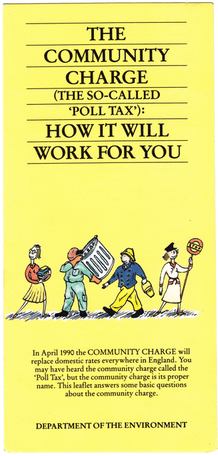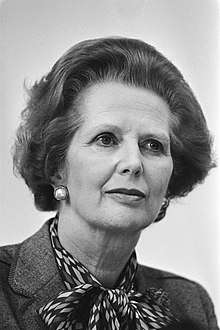Poll tax (Great Britain)
The Community Charge, commonly known as the poll tax, was a system of taxation introduced in replacement of domestic rates in Scotland from 1989, prior to its introduction in England and Wales from 1990. It provided for a single flat-rate per-capita tax on every adult, at a rate set by the local authority. The charge was replaced by Council Tax in 1993, two years after its abolition was announced.[1]

Origins
The abolition of the rating system of taxes (based on the notional rental value of a house) to fund local government had been unveiled by Margaret Thatcher when she was Shadow Environment Secretary in 1974, and was included in the manifesto of the Conservative Party in the October 1974 general election. In the 1979 elections the Conservative manifesto stated that lowering income tax took priority. The Government published a green paper in 1981 under the title Alternatives to Domestic Rates. It considered a flat-rate per-capita tax as a supplement to another tax, noting that a large flat-rate 'poll tax' would be seen as unfair.
The 1980s saw a period of general confrontation between central government and Labour-controlled local authorities, which eventually led to the abolition of the Greater London Council and the six metropolitan county councils. The commitment to abolish the rates was replaced in the 1983 general election manifesto with a commitment to introduce the ability for central government to cap rates which it saw as excessive. This was introduced by the Rates Act 1984.
Although the rates system was supposed to have regular revaluations to minimise discrepancies, the revaluations in England and Wales had been cancelled in 1978 and 1983. The Scottish revaluation of 1985/1986 led to a great deal of criticism and gave added urgency to rates reform or replacement.
The green paper of 1986, Paying for Local Government, produced by the Department of the Environment from consultations between Lord Rothschild, William Waldegrave and Kenneth Baker, proposed the poll tax. This was a fixed tax per adult resident, hence the term 'poll tax', although there was a reduction for poor people. This charged each person for the services provided in their community. Owing to the variations in the amount of local taxes paid and the amount of grant provided by central government to individual local authorities, there were differences in the amount charged between councils.
This proposal was contained in the Conservative manifesto for the 1987 General Election. The legislation introducing the poll tax was passed in 1987, 1988[2] and the new tax replaced the rates in Scotland from the start of the 1989/90 financial year and in England and Wales from the start of the 1990/91 financial year. Additionally, the Uniform Business Rate, levied by local government at a rate set by central government and then apportioned between local authorities in proportion to their population, was introduced.
The tax was not implemented in Northern Ireland, which continued, as it still does as of 2018, to levy the rating system, despite some unionists calling for the region to have the same taxation system as Great Britain.
Implementation
The poll tax when implemented encountered a number of administrative and enforcement difficulties. Some renters did not pay, knowing they would have left Scotland when the bills arrived. Councils of towns with highly mobile populations, such as university towns, were faced with big store rooms of unprocessed "gone-aways". The initial register, which was based on the rates register for "owned" houses, contained many irregularities from supplementary data sources such as housing benefit recipients.
The big collection issue was the 20%/100% split. People in employment had to pay 100%, while students and the registered unemployed paid 20%. The nature of the shared house market meant that not even the landlord knew exactly who was living there; tenants were replaced and may have shared a "single" room with their partner. So the local council did not know who was living where and when.
Councils were burdened with the task of pursuing the large numbers of defaulters, many of whom were acting as part of organised resistance to the charge. There is also some evidence that the poll tax had a lasting effect of people not registering themselves on the electoral register to evade collection attempts. This may have had an effect on the results of the 1992 general election, which ended in a fourth successive Conservative victory, despite most opinion polls pointing to a hung parliament or narrow Labour majority.[3]
Opposition ("Can't Pay! Won't Pay!")

The change from payment based on the worth of one's house to a poll tax was widely criticised as being unfair, and needlessly burdensome on those less well-off. Mass protests were co-ordinated by the All Britain Anti-Poll Tax Federation, other national networks such as 3D (Don't Register, Don't Pay, Don't Collect) and by hundreds of local Anti-Poll Tax Unions (APTUs), which were not aligned to any particular political grouping. In Scotland, where the tax was implemented first, the APTUs called for mass non-payment. As the tax neared its implementation in England, protests against it began to increase. That culminated in a number of Poll Tax riots. The most serious of those was on 31 March 1990 – a week before the implementation of the tax – when between 70,000 and 200,000 people[4] demonstrated against the tax. The demonstration around Trafalgar Square left 113 people injured and 340 under arrest,[5] with over 100 police officers needing treatment for injuries.[6] There were further conflicts and protests, but none on the scale of the Trafalgar Square riot.
As the amount of the poll tax began to rise and the inefficiency of local councils in their collection of the tax became apparent, large numbers of people refused to pay. Local councils tried to respond with enforcement measures, but they were largely ineffective given the huge numbers of non-payers. According to the BBC, up to 30% of former ratepayers in some areas refused to pay.[7]
The anti-poll-tax organisations encouraged non-payers not to register, to clog up the courts by contesting local council attempts to gain liability orders, and ultimately, not to attend court hearings arising from their non-compliance.[8] In November 1990, South Yorkshire police said they were planning to refuse to arrest poll tax defaulters, even when instructed to by the courts, because it would be "physically impossible for the police because of the large number of defaulters".[9]
The opposition Labour Party, at its 1988 annual conference, decided against support for a non-payment campaign.[10] In July 1991, Terry Fields, Labour MP for Liverpool Broadgreen, and a member of the Militant Tendency, was imprisoned for sixty days for refusing to pay. At the time of Fields' jailing, Labour leader Neil Kinnock commented: "Law makers must not be law breakers."[11]
In popular culture, the punk band The Exploited featured the song "Don't Pay The Poll Tax" in their album The Massacre, which was released on 15 April 1990.
Political consequences
After the poll tax was announced, opinion polls showed the Labour opposition opening a strong lead over the Conservative government. After the Poll Tax Riots, Conservative ministers contemplated abolition of the tax but knew that, as a flagship Thatcherite policy, its abolition would not be possible while Thatcher was still Prime Minister.[12] Kinnock had vowed to abolish the poll tax if he won the next general election.[13]
For this, among other reasons, Thatcher was challenged by Michael Heseltine for the Conservative leadership in November 1990. Although she prevailed by a margin of fifty votes, she narrowly missed the threshold to avoid a second vote, and on 22 November 1990 she announced her resignation after more than a decade in office. All three of the contenders to succeed her pledged to abandon the tax.
The successful candidate, John Major, appointed Heseltine to the post of Environment Secretary, responsible for replacing the poll tax. In early 1991 the Chancellor of the Exchequer, Norman Lamont, announced a rise in Value Added Tax from 15% to 17.5% to pay for a £140 reduction in the tax. The abolition of the poll tax was announced on 21 March 1991.[14]
The Conservative government was re-elected for a fourth successive term in office at the 1992 general election, shaking off the strong challenge from the Labour Party. This election defeat prompted the resignation of Labour Party leader Neil Kinnock.
Abolition
By the time of the 1992 general election, legislation had been passed[15] replacing the poll tax with the Council Tax from the start of the 1993/1994 financial year. The VAT rate of 17.5% remained despite an earlier policy of charging a higher poll tax.
Council Tax strongly resembled the rates system the poll tax had replaced. The main differences were at the tax's inception: that properties were placed in bands, thereby capping the maximum amount, and it was levied on capital value, rather than the notional rental value of a property. Households with only one occupant were also entitled to a 25% discount. The only substantial change since the introduction of the Council Tax form of direct taxation is the gradual introduction of certain exemptions and discounts.
See also
| Wikimedia Commons has media related to Community Charge. |
- Poll Tax riots
- Peasants' Revolt – 14th-century rebellion against serfdom and the imposition of a poll tax.
- Tommy Sheridan, Scottish socialist who originally came to prominence protesting against the poll tax.
- Bedroom tax
Notes
- Archived 16 October 2011 at the Wayback Machine
- Local Government Finance Act 1988 http://www.legislation.gov.uk/ukpga/1988/41/contents
- Poll tax in Encyclopedia of Britain by Bamber Gascoigne, HistoryWorld.net
- Graham, David (25 March 2010). "The Battle of Trafalgar Square: The poll tax riots revisited". The Independent. Retrieved 8 April 2013.
- "31 March 1990: Violence flares in poll tax demonstration". On this day 1950–2005. Retrieved 30 October 2008.
- Gross, David M. (2014). 99 Tactics of Successful Tax Resistance Campaigns. Picket Line Press. pp. 125–126. ISBN 978-1490572741.
- BBC News, 'On This Day', 1990 – poll tax non-payment
- Gross, David M. (2014). 99 Tactics of Successful Tax Resistance Campaigns. Picket Line Press. pp. 36–38, 79–80. ISBN 978-1490572741.
- quoted in Organise!, issue 21, Dec–Feb 1991 Archived 26 July 2011 at the Wayback Machine
- Andy McSmith Faces of Labour: The Inside Story, London: Verso, 1996, p.114
- "1991: Anti-poll tax MP jailed", BBC on this Day, 11 July
- "BBC Politics 97". BBC. 9 April 1992. Retrieved 24 December 2013.
- "A coal miner's son. (British Labour Party leader Neil Kinnock) | HighBeam Business: Arrive Prepared". Business.highbeam.com. 14 May 1990. Archived from the original on 11 October 2012. Retrieved 24 December 2013.
- "BBC ON THIS DAY | 1991: Heseltine unveils new property tax". BBC News. 21 March 1960. Retrieved 24 December 2013.
- Local Government Finance Act 1992
Further reading
- Alderman, R. K., and Neil Carter. "A very Tory coup: The ousting of Mrs Thatcher." Parliamentary Affairs 44.2 (1991): 125–139.
- Bagguley, Paul. "Protest, poverty, peni and power : a case study of the anti-poll tax movement", Sociological review, 1995, vol. 43, n° 4, pp. 693–719
- Anti-Poll Tax Community based campaign
- Burns, Danny. Poll Tax Rebellion (AK Press, Stirling, Scotland, 1992.)
- Butler, David, Andrew Adonis, and Tony Travers. Failure in British government: the politics of the poll tax (Oxford UP, 1994).
- Crick, Michael, and Adrian Van Klaveren. "Mrs Thatcher's greatest blunder." Contemporary British History 5.3 (1991): 397–416; the poll tax.
- Gibson, John G. "Voter reaction to tax change: the case of the poll tax 1." Applied Economics 26.9 (1994): 877–884.
